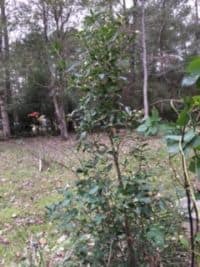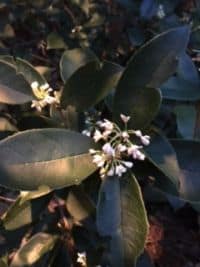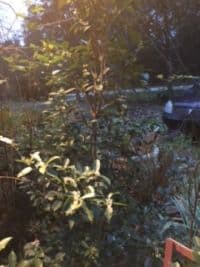
Sweet Olive, Tea Olive, Fragrant Olive
Osmanthus fragrans, commonly known as Sweet Olive, Tea Olive or Fragrant Olive is an evergreen native to China. This plant was cultivated for home gardens and temple gardens. Grown here before 1800, Osmanthus has been cultivated in China for about 2,500 years, and is still of importance there today. It is a popular street tree throughout the warmer parts of China, filling the air with scent on warm autumn evenings. The flowers are widely used as a flavoring in tea, scented jam, wine, sweets and in perfume. In traditional herbal medicine an extract of the stem bark is used to treat boils and carbuncles. The essential oil has insect-repelling properties.

This slow growing shrub can grow to about 15 feet and is long lived and always looks clean with dark green glossy leaves. It has medium texture with dense, compact foliage. Blooms autumn to spring but also throughout the season in cycles brought on by changes in temperatures.
Sweet Olive can be used as a specimen plant and trained as a small tree or espalier. I like to see it as screen or hedge. The inconspicuously small flowers bloom in clusters of white to orange and have a heavy fragrance described as apricot-like but smells like candy to me. Often times you don’t know where the shrub is located but you know it there from the fragrance.

Plant Sweet Olive when dormant or anytime when in containers. They prefer full sun to part shade. For bests results, do not plant directly in our clay soil but plant in well-drained/slightly acidic soil. Do not overwater. Fertilize in late winter with an all-purpose fertilizer. Sweet Olives may sustain damage from temperatures in the low teens. Prune in late winter to shape as needed.
Plant Sweet Olive when dormant or anytime when in containers. They prefer full sun to part shade. For bests results, do not plant directly in our clay soil but plant in well-drained/slightly acidic soil. Do not overwater. Fertilize in late winter with an all-purpose fertilizer. Sweet Olives may sustain damage from temperatures in the low teens. Prune in late winter to shape as needed.
Sweet Olives can be propagated using the same techniques as that of other broadleaf evergreens. Sweet Olives do produce seed, and seed can be sown in the fall, but the containers must be protected from frost. The usual method of propagation is from cuttings of half ripened wood. Propagation from cuttings is done in late fall through winter. This plant has few pests.

Sweet olive is susceptible to a bacterial disease called leaf scorch, which is caused by Xylella fastidiosa. The bacterium is transmitted and spread by xylem-feeding insects, such as sharp shooters, leaf hoppers or spittle bugs. Symptoms of sweet olive leaf scorch include chlorotic mottling of the leaves that starts from the tips and margins and progresses toward the midribs. As the disease develops, leaf tips and margins become necrotic. There are no chemicals available to manage sweet olive leaf scorch. Cultural practices that improve plant vigor, such as proper watering and fertilization, may help infected plants live longer. Positive diagnosis of bacterial leaf scorch can be done by the LSU AgCenter Plant Diagnostic Center.

Osmanthus ‘Nanjing’s Beauty produces more flowers and is more-cold hardy. Another cultivar is ‘Aurantiacus’ with yellow orange flowers. It blooms only once in spring with larger and coarse leaf texture. Osmanthus fragrans is a good old fashioned Southern plant that should be planted more often.
submitted by Karen Blackburn
